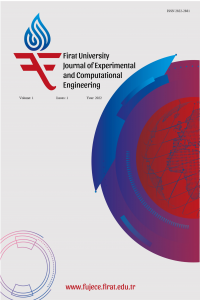SKLBP14: Kare çekirdekli yerel ikili modele dayalı yeni bir dokusal çevresel ses sınıflandırma modeli
Textural ESC dataset, Square-kernelled local binary pattern, Signal classification, Advanced signal processing, Textural feature extraction
SKLBP14: A new textural environmental sound classification model based on a squarekernelled local binary pattern
Dokusal ESC veri seti, Kare çekirdekli yerel ikili model, Sinyal sınıflandırması, Gelişmiş sinyal işleme, Dokusal özellik çıkarma,
___
- [1] Demir K, Berna A, Demir F. "Detection of brain tumor with a pre-trained deep learning model based on feature selection using MR images". Firat University Journal of Experimental and Computational Engineering, 2(1), 23-31, 2023.
- [2] Sevinç A, Özyurt F. "Classification of recyclable waste using deep learning architectures". Firat University Journal of Experimental and Computational Engineering, 1(3), 122-128, 2022.
- [3] Matwin S, Kouznetsov A, Inkpen D, Frunza O, O'Blenis P. "A new algorithm for reducing the workload of experts in performing systematic reviews". Journal of the American Medical Informatics Association, 17(4), 446-453, 2010.
- [4] Salamon J, Bello JP. "Deep convolutional neural networks and data augmentation for environmental sound classification". IEEE Signal processing letters, 24(3), 279-283, 2017.
- [5] Abdoli S, Cardinal P, Koerich AL. "End-to-end environmental sound classification using a 1D convolutional neural network". Expert Systems with Applications, 136, 252-263, 2019.
- [6] Okaba M, Tuncer T. "An automated location detection method in multi-storey buildings using environmental sound classification based on a new center symmetric nonlinear pattern: CS-LBlock-Pat". Automation in Construction, 125, 103645, 2021.
- [7] Zhang Y, Zeng J, Li Y, Chen D. "Convolutional neural network-gated recurrent unit neural network with feature fusion for environmental sound classification". Automatic Control and Computer Sciences, 55, 311-318, 2021.
- [8] Demir F, Abdullah DA, Sengur A. "A new deep CNN model for environmental sound classification". IEEE Access, 8, 66529-66537, 2020.
- [9] Ojala T, Pietikainen M, Maenpaa T. "Multiresolution gray-scale and rotation invariant texture classification with local binary patterns". IEEE Transactions on pattern analysis and machine intelligence, 24(7), 971-987, 2002.
- [10] Ahonen T, Hadid A, Pietikäinen M. "Face recognition with local binary patterns". in European conference on computer vision, 2004: Springer, 469-481.
- [11] Hinton G. "The forward-forward algorithm: Some preliminary investigations". arXiv preprint arXiv:2212.13345, 2022.
- [12] Kotsiopoulos T, Sarigiannidis P, Ioannidis D, Tzovaras D. "Machine learning and deep learning in smart manufacturing: The smart grid paradigm". Computer Science Review, 40, 100341, 2021.
- [13] Hall O, Dompae F, Wahab I, Dzanku FM. "A review of machine learning and satellite imagery for poverty prediction: Implications for development research and applications". Journal of International Development, 2023.
- [14] Tuncer T, Dogan S, Baygin M, Acharya UR. "Tetromino pattern based accurate EEG emotion classification model". Artificial Intelligence in Medicine, 123, 102210, 2022.
- [15] Tuncer T, Dogan S, Pławiak P, Acharya UR, "Automated arrhythmia detection using novel hexadecimal local pattern and multilevel wavelet transform with ECG signals". Knowledge-Based Systems, 186, 104923, 2019.
- [16] Tuncer T, Dogan S, Özyurt F, Belhaouari SB, Bensmail H. "Novel Multi Center and Threshold Ternary Pattern Based Method for Disease Detection Method Using Voice". IEEE Access, 8, 84532-84540, 2020.
- [17] L. E. Peterson, "K-nearest neighbor," Scholarpedia, vol. 4, no. 2, p. 1883, 2009.
- [18] Maillo J, Ramírez S, Triguero I, Herrera F. "kNN-IS: An Iterative Spark-based design of the k-Nearest Neighbors classifier for big data". Knowledge-Based Systems, 117, 3-15, 2017.
- [19] Carrington AM. et al. "Deep ROC analysis and AUC as balanced average accuracy, for improved classifier selection, audit and explanation". IEEE Transactions on Pattern Analysis and Machine Intelligence, 45(1), 329-341, 2022.
- [20] Powers DM. "Evaluation: from precision, recall and F-measure to ROC, informedness, markedness and correlation". arXiv preprint arXiv:2010.16061, 2020.
- Başlangıç: 2022
- Yayıncı: Fırat Üniversitesi
A YARA-based approach for detecting cyber security attack types
Kubra Y ILDIRIM, Mustafa Emre DEMIR, Tugce KELES, Arif Metahan YILDIZ, Sengul DOGAN, Turker TUNCER
Musa YETKİN, Ömer Faruk TAŞ, Erkut SAYIN
Development of an enhanced student identification system
Ajibola OYEDEJI, Ignatius OKAKWU, Olatilewa ABOLADE
Arif Metehan YILDIZ, Mehmet Veysel GUN, Kubra YILDIRIM, Tugce KELES, Sengul DOGAN, Turker TUNCER, U. Rajendra ACHARYA
